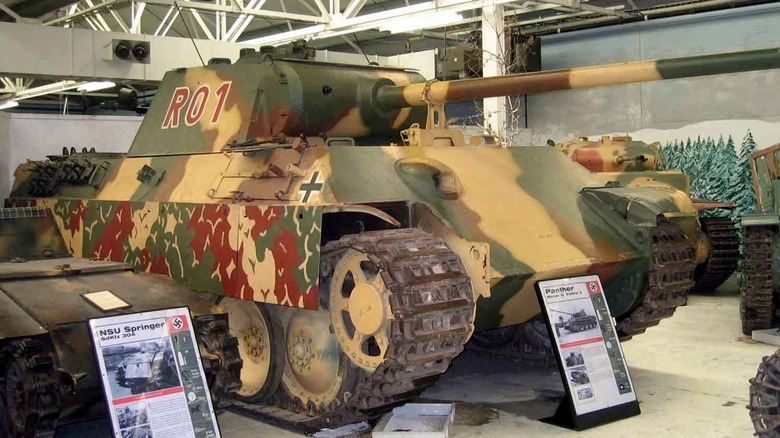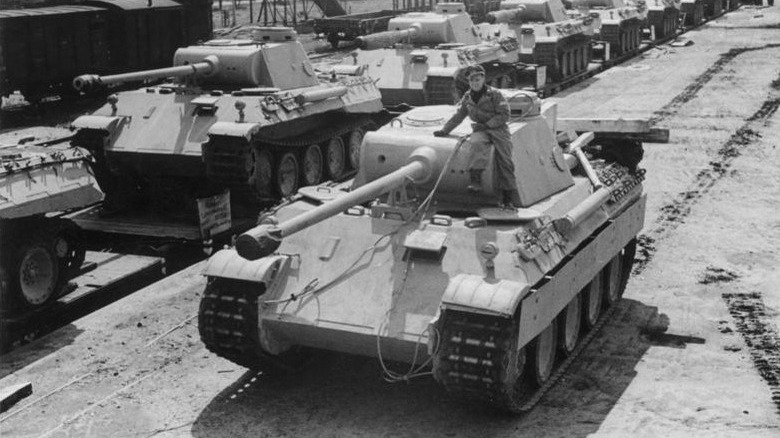Why Germany's WWII Panther Tank Is So Polarizing To Experts
When Germany invaded Russia in the summer of 1941, its Panther IV tanks met heavy opposition from the Soviet's newly unveiled and superior T-34 tanks. According to HowStuffWorks, a German general named Heinz Guderian stated in his diary, "This was the first occasion on which the apparent superiority of the Russian T-34 to our tanks became plainly apparent."
Although a successor for the Panther IV tank was already in the works prior to the start of World War II, it suddenly became the utmost priority. The final design was heavily influenced by the findings of a special tank commission that was sent to the eastern front to gather information.
In a testament to the determination of German military planners, approximately 18 months after the first Russian T-34s were encountered, the new Panther V tanks were being produced and thrust into battle. To improve speed, this new rolling weapon had a 700 horsepower gasoline-powered engine provided by Maybach that boasted a range of 110 miles.
A torsion bar suspension system also allowed the Panther V to traverse uneven terrain with inconsistencies up to 20 inches, a feat that wasn't duplicated until the Leopard 2 tanks entered service more than three decades later.
It was also heavily armored, with some sections on the front sporting five inches thick armor plating. However, the dominating attribute was the Panther V's main gun: a long barreled cannon that was capable of firing a 75mm (approximately three inches) diameter shell that could pierce armor nearly five inches thick, from a distance of almost 1,100 yards.
[Featured image by Mick Knapton via Wikimedia Commons | Cropped and scaled | CC BY-SA 3.0]
The Panther V tank had a major achilles heel
Like many new designs — and especially one as rushed as the Panther V — the tank wasn't without a few bugs that needed ironing out. Some examples of the running changes included the fitting of a second machine gun and a searchlight, a re-designed road wheel, and the elimination of a hatch in the turret in favor of a periscope. In spite of these improvements, there were other reliability concerns with the Panther V that couldn't be remedied as easily, or at all.
Perhaps the weakest link was the Panther V's final drive assembly, which connects the engine to the wheels that turn the massive treads. A study conducted by French experts after the war estimated that the final drive assembly could only travel 150 kilometers before failing.
The French also remarked that the Panther V's engine wasn't altogether reliable either, with issues such as overheating, fuel leaks, and a total lifespan of only 1,000 kilometers. The report wasn't all negative however, as the Panther V's main gun, frontal armor, and outward visibility was praised.
In sharp contrast to the French study, a German document stated that the Panther V could easily travel 1,500 to 2,000 kilometers between engine overhauls. This boast could simply be dismissed as propaganda, but another explanation is that the Germans assessed reliability using well-trained and careful crews, something that might not be duplicated in the field where both soldiers and equipment were being hurried into service.
[Featured image by Unknown via Wikimedia Commons | Cropped and scaled | CC BY-SA 3.0 DE]
Manufacturing and training were both rushed
In summary, not only did the Germans succeed in besting the Soviet T-34, the Panther V could defeat virtually any Allied tank for the remainder of World War II. According to HowStuffWorks, "The rule of thumb in the United States Army was that five M-4 Shermans were required to defeat one Panther."
Indeed, some enthusiasts such as Ralf Raths, director of the Deutsche Panzermuseum in Munster, consider the Panther V tank to be "one of the best designed and best balanced tank designs of the second World War."
On the opposite end of the spectrum, there's no doubt that the tank was rushed through development and subsequent production, resulting in numerous quality control issues, some more permanent than others. These shortcomings were likely further compounded by rough treatment of equipment by tank crews that were hastily trained and pressed into service as the gears of war created attrition of German troops.
By the time that German forces surrendered in May 1945, a total of 5,508 Panther V tanks had been produced.

